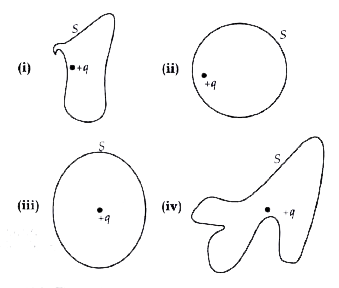The magentic induction in vacumm at a plaen surface of a magentic is equal to B and the vector B forms an angle θ with the normal n of the surface (Fig). The permeability of the magnetic is equal to μ. Find:
(a) the flux of the vector H through the spherical surface S of radius R, whose centre lies on the surface of the magentic,
(b) the circulation of the vector B around the square path I' widh side l located as shwon in the fig.

(a) ∮→H.d.→S=∮(→Bμ0−→J).d→S=−∮→J.d.→S, since ∮→B.d.→S=0
Now →J is nonvanishing only in the bottom half of the sphere.

Here, B'n=Bcosθ,H't=1μ0Bsinθ,B't=μBsinθ,H'n=Bμμ0cosθ
jn=Bcosθμ0(1−1μ) and Jt=μ−1μ0Bsinθ.
Only Jn contributes the surface intergal and
∮→J.d.→S=−∮lower→J.d.→S=∮lower−→JndS=πR2Bcosθμ0(1−1μ)
(b) ∮r→B.d.→r=(Bt−B't)l=(1−μ)Blsinθ
Topper's Solved these Questions
- BOOK - IE IRODOV, LA SENA & SS KROTOVCHAPTER - ELECTRODYNAMICSEXERCISE - Electromagnetic Induction84videos
ELECTRODYNAMICS
- BOOK - IE IRODOV, LA SENA & SS KROTOVCHAPTER - ELECTRODYNAMICSEXERCISE - Motion Of Charged Particle In Magnetic Field36videos
ELECTRODYNAMICS
- BOOK - IE IRODOV, LA SENA & SS KROTOVCHAPTER - ELECTRODYNAMICSEXERCISE - Electric Current72videos
ELECTRODYNAMICS
- BOOK - IE IRODOV, LA SENA & SS KROTOVCHAPTER - ELECTRICITY AND MAGNETISMEXERCISE - All Questions6videos
ELECTRICITY AND MAGNETISM
- BOOK - IE IRODOV, LA SENA & SS KROTOVCHAPTER - ELECTROMAGNETISMEXERCISE - All Questions24videos
ELECTROMAGNETISM
Similar Questions
The magnetic induction in vacumm at a plane surface of a uniform istropic magnetic is equal to B, the vector B forming an angle α with the normal of the surface. The permeability of th emagnetic is equal to μ. Find the magnitic of the magnetic induction B in the magnetic in the vicinity of its surface.
View SolutionFind flux through the hemispherical surface
 View Solution
View Solution
Knowledge Check
- Question 1 - Select One
The electric flux through the surface
 Ain fig, (iv) is the largestBin fig, (iii) is the leastCin fig (ii) is same as a fig (iii) but is smaller than that in Fig (iv).Dis the same for all the figures.
Ain fig, (iv) is the largestBin fig, (iii) is the leastCin fig (ii) is same as a fig (iii) but is smaller than that in Fig (iv).Dis the same for all the figures. - Question 2 - Select One
The electric flux through the surface
 Ain fig. (iv) is the largestBin fig. (iii) is the leastCin fig. (ii) is same as fig.(iii) but is smaller than fig.(iv)DIs the same for all the figures.
Ain fig. (iv) is the largestBin fig. (iii) is the leastCin fig. (ii) is same as fig.(iii) but is smaller than fig.(iv)DIs the same for all the figures. - Question 3 - Select One
The magentic field B at the centre O in fig. shown is
 Aμ0I4[1R1−1R2]Bμ0I4[1R1+1R2]Cμ0I4(R1−R2)Dμ0I4(R1+R2)
Aμ0I4[1R1−1R2]Bμ0I4[1R1+1R2]Cμ0I4(R1−R2)Dμ0I4(R1+R2)
Find flux through the hemispherical surface
 View Solution
View SolutionNear the point plane surface of a uniform isotropic dielectric with permittivity ε the electric field strength in vacumm is equal to E0 the vector E0 forming an angle θ with the normal of the dielectric's surface (FIg). Assuming the field to be uniform both inside and outside the dielectric, Find:

(a) the flux of the vector E through a sphere of radius R with centre located at the surface of the dielectric,
(b) the circulation of the vector D around the closed path I' og length l (see fig) whose plane is perpendicular to the surface of the dielectric and parallel to the vector E0.
 View Solution
View SolutionThe electric flux through the surface :
 View Solution
View SolutionThe net magnetic flux through any closed surface, kept in a magnetic field is
View SolutionThe net magnetic flux through any closed surface, kept in a magnetic field is
View Solution

